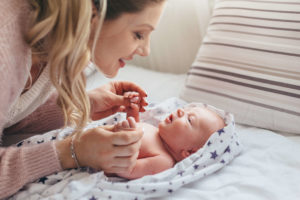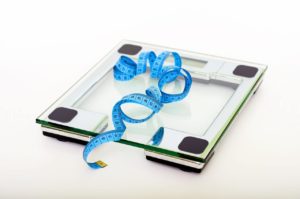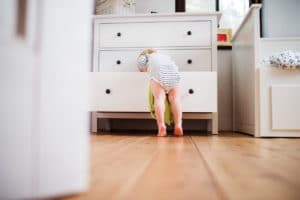Why my baby should learn to sit by itself?
What can you do to help your baby build stable muscles ? When does my baby start to sit and what do I have to keep in mind? Did you know that your baby starts to show signs of walking in the 16th week of pregnancy? You can find out all about this here.
Table of contents
When Will My Baby Be Able To Sit?
Because every baby is different, it takes a different amount of time for your baby to be able to sit by himself. However, it is said that babies start to be able to sit independently on average between the 5th and 9th month.
Initially at birth, an infant’s spine has a “C” shape, which is not a good shape for sitting. Overall, it takes about a year of life for the spine to develop into a double “S” shape.
A Lot Of Movement Is Very Good And Necessary
The first and also most important prerequisite for your baby to learn to sit on his own is to build up all the necessary muscles. Don’t worry, you won’t have to go to the gym with your baby, because babies train their muscles all by themselves.
For example, the baby trains by lying on his stomach, crawling and sometime later, by roaming. They say, “The more the baby moves, the stronger the muscles become.”
Important: You as a parent should definitely support your baby’s urge to move and offer your darling enough opportunities to let off steam. Even if it doesn’t work after several attempts, you should remain patient and wait until your baby learns to sit by itself.
There Are Two Different Types Of Sitting For Babies:
-> passive sitting: This term means that the baby cannot sit upright on its own, but only with the help of aids such as someone else’s help on the lap or with the help of an object such as a pillow.
-> Active sitting: Active sitting means that your baby can sit on his own without help and has free hands, for example, to eat something or can also use for playing.
As soon as your baby has managed to sit on its own, you should nevertheless not overload the still tender spine by making it sit for several hours in the car, for example. This is very damaging to the spine and can, in the worst case, lead to a malformation in the spine. For this reason, you should take regular breaks during long car journeys.
Baby Development
Around the 3rd to 4th month, your baby learns to hold its head on its own. To do this, it is particularly important that the shoulder and neck muscles are strong enough. If your baby manages to hold his head for about one minute, he has passed the first phase.
Between the 5th and 9th month, your baby will learn to sit independently. A lot of crawling strengthens the abdominal and back muscles. Besides the strong muscles and slowly shaped S-spine, a so-called neural structure is important, which connects brain structures in the cerebellum.
At five to six months, the baby purposefully grabs toys, switches them from one hand to the other and can hold two things at the same time.
Your baby learns to seal around 7 to 10 months. Sealing is a great way for a baby to continue to strengthen his muscles.
In the 8th to actually 20th month, most babies start to take their first steps without assistance. Already in the womb, at about the 16th week of pregnancy, you can feel the first kicks in the belly, which indicate a walking-like movement.
When Can My Baby Sit In The Stroller?
Up to the 9th month, your baby should best be driven lying down. From the 10th month, or when your baby has learned to sit, it can be driven sitting in the stroller.
If Your Baby Cannot Sit Yet
Your baby doesn’t want to sit yet? No need to panic. Every baby learns at a different pace, and that’s the way it should be. What you should never do is sit your baby down, even though he or she is not yet able to sit by himself or herself.
Apparently, your baby’s back muscles are not yet strong enough to hold the heavy head and itself. In the worst case, this can lead to postural deformities that could later cause a crooked spine.
For this reason, you should give your baby as much time as he or she needs. However, if your baby exceeds 14 months and still cannot walk, you should take your baby to the pediatrician to simply check that everything is fine.












